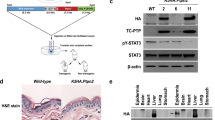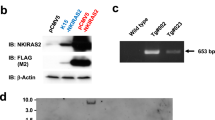Abstract
We previously showed that the EP2 knockout mice were resistant to chemically induced skin carcinogenesis. The purpose of this study was to investigate the role of the overexpression of the EP2 receptor in mouse skin carcinogenesis. To determine the effect of overexpression of EP2, we used EP2 transgenic (TG) mice and wild-type (WT) mice in a DMBA (7,12-dimethylbenz[α]anthracene)/TPA (12-O-tetradecanoylphorbol-13-acetate) two-stage carcinogenesis protocol. EP2 TG mice developed significantly more tumors compared with WT mice. Overexpression of the EP2 receptor increased TPA-induced keratinocyte proliferation both in vivo and in vitro. In addition, the epidermis of EP2 TG mice 48 h after topical TPA treatment was significantly thicker compared to that of WT mice. EP2 TG mice showed significantly increased cyclic adenosine monophosphate levels in the epidermis after prostaglandin E2 (PGE2) treatment. The inflammatory response to TPA was increased in EP2 TG mice, as demonstrated by an increased number of macrophages in the dermis. Tumors and 7 × TPA-treated and DMBA-TPA-treated (6 weeks) skins from EP2 TG mice produced more blood vessels than those of WT mice as determined by CD-31 immunostaining. Vascular endothelial growth factor (VEGF) protein expression was significantly increased in squamous cell carcinoma (SCC) samples from EP2 TG mice compared that of WT mice. There was, however, no difference in the number of apoptotic cells in tumors from WT and EP2 TG mice. Together, our results suggest that the overexpression of the EP2 receptor plays a significant role in the protumorigenic action of PGE2 in mouse skin.
This is a preview of subscription content, access via your institution
Access options
Subscribe to this journal
Receive 50 print issues and online access
$259.00 per year
only $5.18 per issue
Buy this article
- Purchase on Springer Link
- Instant access to full article PDF
Prices may be subject to local taxes which are calculated during checkout






Similar content being viewed by others
References
Cao Y, Prescott SM . (2002). J Cell Physiol 190: 279–286.
Chang SH, Ai Y, Breyer RM, Lane TF, Hla T . (2005a). Cancer Res 65: 4496–4499.
Chang SH, Liu CH, Conway R, Han DK, Nithipatikim K, Trifan OC et al. (2004). Proc Natl Acad Sci 101: 591–596.
Chang SH, Liu CH, Wu MT, Hla T . (2005b). Prostaglandins Other Lipid Mediat 76: 48–58.
Conconi MT, Bruno P, Bonali A, De Angeli S, Parnigotto PP . (1996). Ann Anat 178: 229–236.
Desdouets C, Matesic G, Molina CA, Foulkes NS, Sassone-Corsi P, Brechot C et al. (1995). Mol Cell Biol 15: 3301–3309.
Fischer SM, Lo HH, Gordon GB, Seibert K, Kelloff G, Lubet RA et al. (1999). Mol Carcinog 25: 231–240.
Fischer SM, Patrick KE, Patamalai B, Slaga TJ . (1990). Carcinogenesis 11: 991–996.
Furstenberger G, Gross M, Marks F . (1989). Carcinogenesis 10: 91–96.
Hoper MM, Voelkel NF, Bates TO, Allard JD, Horan M, Shepherd D et al. (1997). Am J Respir Cell Mol Biol 17: 748–756.
Kawamori T, Kitamura T, Watanabe K, Uchiya N, Maruyama T, Narumiya S et al. (2005). Carcinogenesis 26: 353–357.
Kitamura T, Itoh M, Noda T, Tani K, Kobayashi M, Maruyama T et al. (2003). Cancer Sci 94: 618–621.
Lu X, Xie W, Reed D, Bradshaw WS, Simmons DL . (1995). Proc Natl Acad Sci 92: 7961–7965.
Müller-Decker K, Scholz K, Marks F, Furstenberger G . (1995). Mol Carcinog 12: 31–41.
Murphy JE, Morales RE, Scott J, Kupper TS . (2003). J. Immunol 170: 5697–5703.
Mutoh M, Watanabe K, Kitamura T, Shoji Y, Takahashi M, Kawamori T et al. (2002). Cancer Res 62: 28–32.
Nishihara H, Kizaka-Kondoh S, Insel PA, Eckmann L . (2003). Proc Natl Acad Sci 100: 8921–8926.
Seno H, Oshima M, Ishikawa TO, Oshima H, Takaku K, Chiba T et al. (2002). Cancer Res 62: 506–511.
Shao J, Evers BM, Sheng H . (2004). J Biol Chem 279: 14287–14293.
Shao J, Lee SB, Guo H, Evers BM, Sheng H . (2003). Cancer Res 63: 5218–5223.
Shaywitz AJ, Greenberg ME . (1999). Ann Rev Biochem 68: 821–861.
Sheng H, Shao J, Morrow JD, Beauchamp RD, DuBois RN . (1998). Cancer Res 58: 362–366.
Solomon SD, McMurray JJ, Pfeffer MA, Wittes J, Fowler R, Finn P et al. (2005). N Engl J Med 17: 1071–1080.
Sonoshita M, Takaku K, Sasaki N, Sugimoto Y, Ushikubi F, Narumiya S et al. (2001). Nat Med 7: 1048–1051.
Sung YM, He G, Fischer SM . (2005). Cancer Res 65: 9304–9311.
Suzukawa K, Weber TJ, Colburn NH . (2002). Environ Health Perspect 110: 865–870.
Tiano HF, Loftin CD, Akunda J, Lee CA, Spalding J, Sessoms A et al. (2002). Cancer Res 62: 3395–3401.
Ueda T, Akiyama N, Sai H, Oya N, Noda M, Hiraoka M et al. (2001). FEBS Lett 491: 40–44.
Watanabe H, Date K, Itoi T, Matsubayashi H, Yokoyama N, Yamano M et al. (1999). Ann Oncol 10: 136–139.
Young MR, Yang HS, Colburn NH . (2003). Trends Mol Med 9: 36–41.
Yuspa SH, Harris CC . (1974). Exp Cell Res 86: 95–105.
Acknowledgements
We appreciate the excellent technical support of Amy Pavone, Carol Mikulec, Jennifer KL Colby and Dr Joyce E Rundhaug for helping in the manuscript preparation. This work was supported by grants CA100140 and CA16672 from the NCI and ES07784 from the NIEHS.
Author information
Authors and Affiliations
Corresponding author
Rights and permissions
About this article
Cite this article
Sung, Y., He, G., Hwang, D. et al. Overexpression of the prostaglandin E2 receptor EP2 results in enhanced skin tumor development. Oncogene 25, 5507–5516 (2006). https://doi.org/10.1038/sj.onc.1209538
Received:
Revised:
Accepted:
Published:
Issue Date:
DOI: https://doi.org/10.1038/sj.onc.1209538



